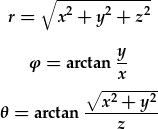
The Cartesian reference frame is particularly convenient as its three coordinates are equivalent: A translation by 5cm along x is the same as a translation by 5cm along y apart from the direction. However, any triple of linearly independent coordinates are equally well suited to describe the position of an object in space uniquely. Instead of lengths along the coordinate axes, angles can be used as coordinates.
The latitude-longitude system used to fix positions on the surface of the Earth is an example of this: Latitude is the angle between the equator plane and the rotation axis of the planet; longitude is the angle between the Greenwich meridian and the projection of the point into the equator plane. Because the distance from the Earth's centre is irrelevant (and approximately constant for purposes of surface navigation), two coordinates suffice. If we were to use a Cartesian frame, x y and z would all be different for each point on the surface. Therefore, the latitude-longitude system makes use of the symmetry of the problem.
Generally, it is a good idea to use a spherical reference frame (one length, two angles) for objects with spherical symmetry (such as atoms) and an axial frame (two lengths, one angle) for objects with axial symmetry (such as chemical bonds).

The spherical reference frame usually used in physics differs slightly from the latitude-longitude frame: There are no longitudes west of Greenwich - instead the corresponding angular coordinate runs clockwise up to 360o. Note that the polar angle is defined as the angle with the z axis, not with the xy plane (as in the geographical latitude). The spherical coordinates are:
| To transform from spherical coordinates into Cartesian: |  |
| ...and back: |

|
Since the three coordinates are not equivalent now, the del operator takes on a slightly more complicated form in spherical coordinates. To solve the Schrödinger equation, we need to apply its square to the trial wave function.
| Del-squared applied to a function, f: |

|
| The first derivative w.r.t. x expressed in spherical coordinates: |

|
The first derivatives with respect to y and z are determined analogously, and then the second
derivatives can be obtained. Try it yourself - it isn't difficult although maybe a bit tedious.
It is quite gratifying, though, when you derive yourself where the factors in front of and between
the differentials arise in the final formula. Here is what you should get:

Note that, unlike in the Cartesian frame, the three terms are not independent from each other: The
polar term contains the radius as a parameter, and the
azimuth term contains both the radius and the polar angle as parameters.